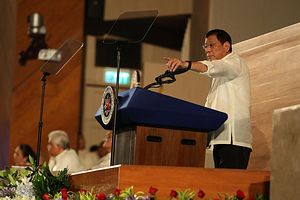Since coming to office in June, Philippine President Rodrigo Duterte has sought to diversify his country’s foreign policy away from its traditional ally the United States and toward other major powers, principally China. Though Duterte is hardly the first Philippine leader to attempt such a rebalance and the economic imperative of closer ties with China is clear, many wondered whether and how he would be able to achieve such a shift in the defense realm (See: “The Limits of Duterte’s China-US Rebalance”).
Over the past few weeks, the parameters within which Duterte will be operating have become increasingly clear. U.S.-Philippine military cooperation has been downgraded somewhat but much of it is still set to continue as of now despite his rhetoric (See: “How Much Will Duterte Wreck the US-Philippines Military Alliance?”). Duterte has also been touting potential economic and military deals with China beyond the string of initial agreements inked during his October visit to Beijing, even though this has at times been met with more cautious responses on the Chinese side and much of the collaboration is still at its initial stages (See: “Duterte Says Philippines Will Accept China Deal”).
But on Tuesday, we got the clearest confirmation yet of a significant military deal between the two sides. Philippine Defense Secretary Delfin Lorenzana told reporters that during a meeting with Duterte on Monday night, China’s Ambassador to the Philippines Zhao Jianhua had offered to provide $14.4 million worth of equipment to Manila for free in what would be considered military assistance.
Lorenzana did not offer much in the way of detail, saying that China had given the Philippines a list of military equipment to be used for fighting drugs and terrorism and that Manila would go through it to find out what it really needed, with a technical working team soon being deployed to Beijing. But he did indicate that the items would include things like small arms, fast boats, and night vision goggles. He also suggested that the deal would be finalized by the end of the year and that the Philippine government hoped to get the equipment by the second quarter of 2017, which would constitute a rather quick turnaround time.
Though the $14.4 million deal is significant if realized, Lorenzana himself characterized the amount as “not that much.” It is hard to disagree with that. For perspective, the United States provided the Philippines with over $120 million in military aid in 2016, with $79 million coming from Foreign Military Financing (FMF) – an increase from $50 million in 2015 – and $42 million coming from the new Southeast Asia Maritime Security Initiative (See: “America’s New Maritime Security Initiative for Southeast Asia”). Indeed, even though Duterte has repeatedly criticized the low level of military assistance that the United States has provided to the Philippines, the fact remains that it is still far higher than what he has gotten from Beijing thus far.
However, many media outlets missed the fact that Lorenzana had also mentioned a separate $500 million long-term soft loan for other equipment. That amount is much more significant than the $14.4 million deal, though it is a loan instead of aid and it is likely spread out over a much longer time horizon. Lorenzana did not provide any more specifics on this loan arrangement publicly.
To be fair, it is still early days in the defense relationship between China and the Philippines. Indeed, the very fact that aid is being doled out by Beijing so early on is itself remarkable considering the poor state of ties just a few months ago before Duterte took office after years of saber-rattling in the South China Sea under Benigno Aquino III. As with other instances in Southeast Asia where Beijing is beginning to make inroads, however, things should be kept in perspective amidst the hype.

































